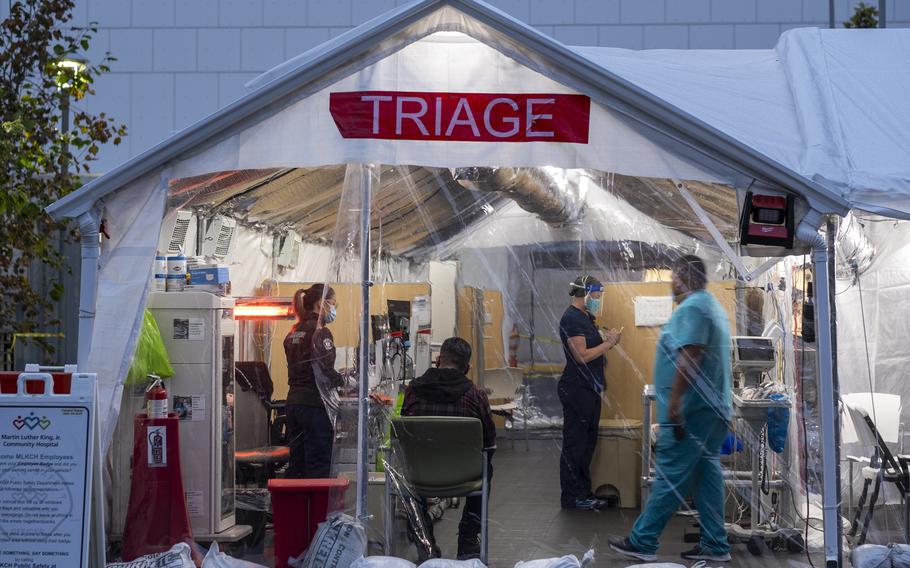
The triage tent outside the emergency department at MLK Community Hospital on Jan. 13, 2022, in the Willowbrook neighborhood of Los Angeles. (Francine Orr, Los Angeles Times/TNS)
Stars and Stripes is making stories on the coronavirus pandemic available free of charge. See more stories here. Sign up for our daily coronavirus newsletter here. Please support our journalism with a subscription.
(Tribune News Service) — U.S. hospital admissions for COVID-19 are receding in 34 states and the nation’s capital, easing the health care staffing crises that were widespread at the start of the year.
In the past week, the number of new COVID-19 patients has dropped 31% in New Jersey and in Maryland, the biggest declines in the country, according to data from the U.S. Department of Health and Human Services. In Washington, D.C., Connecticut and New York, the admissions declined 26% apiece.
The fast-spreading omicron variant swept across the U.S. through much of December and early January, sending cases to a weekly peak more than three times as bad as the previous worst period, last winter. The number of infections meant that hospitals became overwhelmed yet again, even with a variant less virulent for the average infected person.
Omicron moved so quickly that it began to burn out much quicker than previous variants, as it did in South Africa and parts of Europe.
Laggard states
Even among U.S. states hit later with omicron, conditions may soon improve. Oregon, Wyoming and Alaska are reporting the country’s largest increases in new hospital admissions, up 16%, 15% and 15%, respectively, from the previous seven-day period.
But cases, which tend to lead hospital admissions, are showing signs of peaking in those places. Emergency-department visits, another leading indicator of admissions, also appeared to have crested in those areas.
Staffing challenges
In the U.S., that has all meant a sharp recovery for health-care facilities, which were reporting widespread critical staffing shortages as recently as early January — a reflection not only of the number of new COVID-19 patients, but also of an exhausted workforce, many of whom caught omicron themselves.
Since Jan. 9, the number of U.S. health care facilities reporting critical staffing shortages has plummeted to the lowest since Aug. 14.
None of that means that the omicron story is over for America’s doctors and nurses. The situation still looks dire inside intensive care units. It can take days or even weeks for a COVID infection to lead to an ICU admission, so the trend typically lags other data that focus on infections.
ICU occupancy may now be cresting nationally, at a level nearly as bad as the winter of 2020-2021.
In New York, Gov. Kathy Hochul said Monday that the federal government was deploying military medical teams to upstate hospitals, part of a trend as omicron works its way through rural parts of many states.
Now, the U.S. will wait to see what the next season brings. The nation has been through several hopeful lulls after surges, including after last winter’s. But serious surges have tended to occur at least every six months — with a few smaller regional outbreaks in between.
Vaccinations will help. The latest data from December show that unvaccinated seniors were about 52 times more likely to be hospitalized with COVID-19 than their vaccinated and boosted peers, according to COVID-Net, a surveillance network comprising 99 counties in 14 states. In addition to the vaccinations, scientists expect new therapeutics will make future outbreaks or surges more manageable.
©2022 Bloomberg L.P.
Visit bloomberg.com.
Distributed by Tribune Content Agency, LLC.